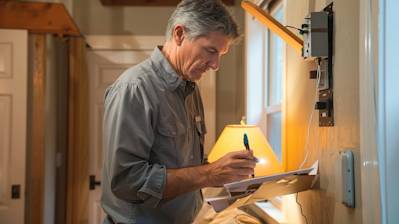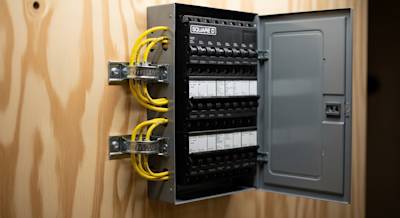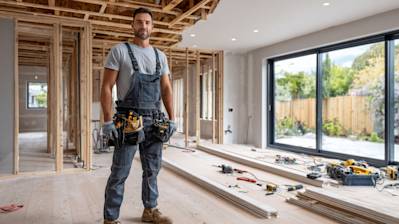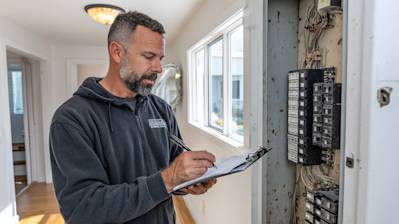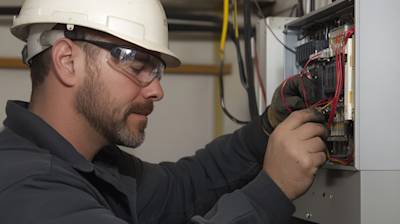Carbon monoxide (CO) is a deadly, colorless, odorless, poisonous gas. It is produced by the incomplete burning of various fuels, including coal, wood, charcoal, oil, kerosene, propane, and natural gas. Equipment and appliances powered by internal combustion engines also produce CO. And herein lies the need for carbon monoxide detectors in the home. Following the appropriate guidelines for carbon monoxide detector placement can save lives. This article delves into the importance of proper placement for CO detectors, and how they work to protect household members from danger.
Understanding Carbon Monoxide and Its Risks
People may not realize they're inhaling CO. Over time, a build-up of this harmful gas can lead to severe health implications, including neurological damage, organ failure, and even death. People most at risk are those with heart disease, pregnant women, and children. Regular exposure to low levels may also cause symptoms such as headaches, nausea, dizziness, and confusion.
The need to detect this invisible killer is paramount, and this is where carbon monoxide detectors come into play. They alert occupants of the presence of CO in the home before it becomes a serious threat. However, to perform this critical function effectively, the placement of your CO detectors is essential.
Key Considerations for Carbon Monoxide Detector Placement
Proper placement of your CO detector is not as simple as securing it to a wall or ceiling. Several points need consideration to ensure optimum performance.
Placement in Relation to Appliances
Devices that burn fuel are foremost in emitting CO. Therefore, installing detectors near these appliances - such as heaters, furnaces, stoves, and fireplaces - would seem practical. However, experts recommend that detectors should not be placed within five feet of these appliances to prevent false alarms due to minor CO emissions upon start-up.
Placement in Sleeping Areas
As the effects of carbon monoxide are heightened during sleep, it is crucial to install detectors in all sleeping areas. Ideally, each bedroom should have a detector, or one placed in close proximity if the bedrooms are situated close to each other.
Placement in Relation to Heating Vents and Windows
CO detectors should be placed at least 15 feet away from heating vents or away from areas with high ventilation, such as windows or doors. High airflow can potentially dissipate the concentration of CO, impeding the detector's ability to identify dangerous levels of the gas.
Additional Placement Advice
There are several other important points to keep in mind regarding the placement of your CO detector.
- Avoid placing detectors near the top of peaked or cathedral ceilings. The higher parts of such ceilings can allow CO to accumulate, thus delaying the alarm.
- Keep detectors away from excessively humid areas such as bathrooms and kitchens, where high humidity and steam can trigger false alarms.
- If you have a multi-story home, the detector should be placed on each level for maximum coverage, especially near stairways to help the alarm sound travel farther.
Maintenance to Make Sure Detectors Function Correctly
Establishing a regular maintenance routine is crucial to make sure your CO detectors are functioning correctly and accurately. This includes:
- Checking the battery of battery-operated detectors at least twice a year.
- Testing the device with the 'test' button according to the suggested frequency mentioned in the manual.
- Regularly replacing the detectors based on their manufacturer-provided expiration date.
The Final Verdict: Safety is Paramount
When it comes to protecting yourself and your loved ones from carbon monoxide, your best defense is early detection. Choose detectors that meet the standards of Underwriters Laboratories (UL). And, remember, no matter the model, no carbon monoxide detector can do its job if it's not placed properly.
To conclude, the importance of proper carbon monoxide detector placement cannot be overstated. Keeping the above tips and recommendations in mind, you should be well-equipped to create a safer environment in your home.
Frequently Asked Questions About Carbon Monoxide Detector Placement
Where should I place a carbon monoxide detector in my home?
It is crucial to place carbon monoxide detectors near your bedrooms and on every floor of your home. Your bedroom is the most crucial place because high levels of carbon monoxide can cause severe sleep-related injuries. Additionally, positioning them at least five feet from the floor helps prevent false alarms from common household items.
Should carbon monoxide detectors be placed high or low?
While smoke detectors should be placed high since smoke rises, carbon monoxide mixes with air and doesn't necessarily rise to the ceiling or sink to the floor. Still, optimal placement is at least 5 above the floor but not on the ceiling. This helps prevent falsely triggering the alarm by everyday household items that can produce small amounts of carbon monoxide.
Why should carbon monoxide detectors be near bedrooms?
Sleeping individuals have a lower likelihood of recognizing early carbon monoxide symptoms. Therefore, detectors should be near sleeping areas to wake individuals in the event of an emergency, potentially saving lives.
Can I place a carbon monoxide detector in the garage?
It's not recommended to place a carbon monoxide detector in your garage due to the presence of gasoline and exhaust fumes, which can trigger a false alarm. Detectors should be placed where people spend most of their time and where the risk of CO poisoning is highest.
Should I install a carbon monoxide detector in the kitchen?
Aiming for comprehensive coverage, it's beneficial to have a detector within 10 feet of your kitchen. However, don't place it very close to the stove as cooking might trigger false alarms. Remember, kitchen appliances, if not correctly vented, can become potential carbon monoxide sources.
Can I place a carbon monoxide detector near a window?
Placing a carbon monoxide detector near a window, air vent, or fan isn't recommended as fresh air could dilute the carbon monoxide concentration, delaying or preventing the alarm from sounding.
How many carbon monoxide detectors do I need?
Ideally, you should install a carbon monoxide detector on each floor of your home, including basements and attics, and near each sleeping area. For larger homes, additional detectors may be necessary to ensure full coverage.
Is one carbon monoxide detector enough for a house?
While better than none, a single detector may not adequately cover a multilevel home or larger square footage. Ensuring each level, including basements and attics, and near each sleeping area has a detector provides comprehensive protection against potential carbon monoxide hazards.
What should I look for in a carbon monoxide detector?
When purchasing, look for detectors endorsed by reputable testing laboratories. Some detectors offer digital displays for easy monitoring, others provide battery backups for power outages. Some even connect to smart home systems or provide voice alerts. Choose the options best fitting your needs and budget.
Can carbon monoxide go through walls?
Yes, carbon monoxide can penetrate drywall and other common household materials. That's why it's important to have detectors throughout your home and not depend on one detector to cover multiple rooms or levels.
How often should I replace my carbon monoxide detectors?
Most carbon monoxide detectors have a life span of about five to seven years. After this period, they may not work correctly, even with fresh batteries. Hence, for safety, it is recommended to replace all detectors every 5-7 years or as recommended by the manufacturer.
Can I plug in a carbon monoxide detector?
Yes, some carbon monoxide detectors are designed to plug into a wall outlet. However, it's crucial to select a model with a battery backup to ensure operation during power outages. Various models are hardwired and require professional installation.
Summary
Taking into account everything learned about carbon monoxide detector placement, it's clear this process requires both attention and care. Incorrect placement can lead to false safety, where the presence of deadly and odorless carbon monoxide gas may not be detected in time. Proper placement of the detectors can make a life-saving difference, ensuring you and your family are alerted promptly if the invisible, deadly gas is present.
Remember, carbon monoxide detector placement is not something to take lightly or cut corners on. Putting detectors near heat sources, where they might not function correctly, or high up where the gas might not reach as quickly, diminishes their effectiveness. Above all, it's crucial to have a detector on every floor and near sleeping areas, since carbon monoxide incidents can frequently occur during sleep.
Lastly, it's extremely important not to view a carbon monoxide detector as a "set it and forget it" device. After the correct placement, it's equally essential to ensure that the detectors are regularly maintained and their batteries replaced timely. With the right knowledge, approach, and vigilance around carbon monoxide detector placement and maintenance, the silent threat of carbon monoxide can be effectively neutralized.
About Sagan Electric
Welcome to Sagan Electric, a renowned electronic service company based in Sacramento, CA. With a history rooted in unparalleled service and customer satisfaction, Sagan Electric prides itself in offering top-grade services rooted in expertise and innovation. From residential to commercial projects, our well-versed professionals have consistently provided comprehensive, sustainable solutions tailored to the needs of the clients. Explore our electrifying world, where commitment meets excellence.
Tags: Carbon Monoxide, Detector Placement, Safety Tips,



